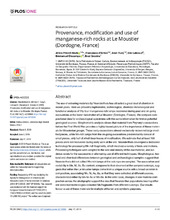Provenance, modification and use of manganese-rich rocks at Le Moustier (Dordogne, France)
Pitarch Marti, Africa; d'Errico, Francesco; Turq, Alain; Lebraud, E; Discamps, Emmanuel; Gravina, Brad
Peer reviewed, Journal article
Published version

Åpne
Permanent lenke
https://hdl.handle.net/1956/22271Utgivelsesdato
2019-07-17Metadata
Vis full innførselOriginalversjon
https://doi.org/10.1371/journal.pone.0218568Sammendrag
The use of colouring materials by Neanderthals has attracted a great deal of attention in recent years. Here we present a taphonomic, technological, chemical-mineralogical and functional analysis of fifty-four manganese rich lumps recovered during past and on-going excavations at the lower rockshelter of Le Moustier (Dordogne, France). We compare compositional data for archaeological specimens with the same information for twelve potential geological sources. Morphometric analysis shows that material from Peyrony’s excavations before the First World War provides a highly biased picture of the importance of these materials for Mousterian groups. These early excavations almost exclusively recovered large modified pieces, while Mn-rich lumps from the on-going excavations predominantly consist of small pieces, only half of which bear traces of modification. We estimate that at least 168 pieces were not recovered during early work at the site. Neanderthals developed a dedicated technology for processing Mn-rich fragments, which involved a variety of tools and motions. Processing techniques were adapted to the size and density of the raw material, and evidence exists for the successive or alternating use of different techniques. Morphological, textural and chemical differences between geological and archaeological samples suggest that Neanderthals did not collect Mn-rich lumps at the outcrops we sampled. The association and variability in Mn, Ni, As, Ba content, compared to that observed at the sampled outcrops, suggests that either the Le Moustier lumps come from a unique source with a broad variation in composition, associating Mn, Ni, As, Ba, or that they were collected at different sources, characterized either by Mn-Ni-As or Mn-Ba. In the latter case, changes in raw material composition across the stratigraphy support the idea that Neanderthal populations bearing different stone tool technologies collected Mn fragments from different outcrops. Our results favour a use of these materials for multiple utilitarian and symbolic purposes.
